 copy.jpg)
Star villages of South Oxfordshire
Star villages are my favourite villages. I recommend them because I think they are amongst the most attractive in South Oxfordshire, or they have interesting features that makes a visit really worthwhile.
|
Dotted along the narrow village streets are picturesque black and white thatched cottages. There are many houses still standing which date back to Tudor times, or even before. Brightwell and Sotwell were originally two separate villages and only combined into one in 1948. There are several ways to get to the village from the main road, and if you use High Road you may well find you are back on the main road again without seeing much of the village! Best to use the first signposted route whether you approach from Wallingford or Didcot! |
|
A small brook runs along the High Street for the length of the village and forms an attractive feature, complete with ducks. Many of the properties along that side of the road have individual bridges across the brook for access. Apparently the brook is man-made and was created in the 19th century, forming an artificial loop to the Chalgrove Brook. The best part of the village for the visitor is undoubtedly the High Street although in some other places there are still some indications of the original village, especially near the church. |
|
In the main the village is bypassed by the Main road so High Street is largely quiet and unspoiled, although between the bridge and the A415 traffic lights it can be busy. Clifton Hampden bridge is very attractive and worth crossing as the well-known Barley Mow pub is on the other side. The village and The Barley Mow were featured in Jerome K. Jerome's book Three Men in a Boat, and in 1885 Dickens's Dictionary of the Thames said of Clifton Hampden, 'Clifton Hampden, this picturesque little village, is situated at the foot of a bold bluff, which rises abruptly from the somewhat flat country around. The cliff is surmounted by the church and vicarage, and is clothed with luxuriant trees down to the water's edge. The village, a pretty collection of old-fashioned cottages, all of which are bright with flowers ...' This description could have been written today. The old fashioned cottages are still there, many of them listed, and the whole makes for a very attractive scene well worth a visit. |
|
Along the High Street are a number of fine period buildings which give the village its special character. Two coaching inns remain out of the original ten, and antique shops are very prominent in the High Street. The remains of the Iron Age settlement are evident by the low hills known as the Dyke Hills which lie close to the river at the edge of the village. |
|
According to legend, the Great Fire of Hagboume in 1659 destroyed cottages that stretched over the fields all the way to nearby West Hagboume. The Great fire certainly happened but the legend has been proved a myth as the fire was restricted to the part of the village east of St. Andrew's Church, and away from West Hagbourne, and Domesday records prove that the two villages were actually never linked and have always been separate communities! In fact had they been linked they would have been a very large settlement indeed, most unusual for the 15th century! |
6 Ewelme
In the centre of the village is the source of the Ewelme Brook and an attractive pond. At the west end of the village on slightly higher ground is the large and attractive 14th/15th century parish church of St. Mary the Virgin, which has had comparatively minor restoration and alteration since then. In the churchyard is the grave of Jerome K. Jerome, the author of 'Three Men in a Boat', who lived in Ewelme in the 1880s. From the west door of the church a covered passage leads to the Cloister - a square courtyard surrounded by thirteen red brick almshouses which were established in 1437. The almshouses are the oldest brick buildings in this part of the country. Next to the Cloister is Ewelme school which was founded originally as a superior grammar school. Now the school is a state primary school and is the oldest school building in the country to be in use as a state primary school. The School is a fine rectangular red brick building two storeys high. The upper classroom has magnificent roof beams, probably made from ship's timbers and has mullioned windows supported by corbels. The Ewelme Brook was at one time used extensively for the cultivation of water cress. The Ewelme water cress beds are now owned and managed by the Chiltern Society as a local nature reserve. They run the whole length of the village and are accessible from the road in places. |
7 Goring
Next to the bridge is Goring Lock and weir, and from the bridge you can look down and watch the lock in use. By the bridge also is the old mill but this is no longer in use. It is thought that Goring Lock was build by the local miller in the C16 to provide a head of water to drive the water wheel. High Street can be very busy with traffic, but some of the side roads are quieter and certainly worth exploring. |
|
High Street is the main attraction and frankly there is little more to see. Along High Street there are many lovely period buildings including, on the north side of the High Street, Cruck Cottage which dates from the C14 which is believed to be the oldest house in South Oxfordshire. Originally this was a single storey, open hall house, without a chimney, which was added during the reign of Elizabeth I. As well as Cruck Cottage there are six other cruck-framed buildings in village which may be 600 or more years old. The western part of the High Street is relatively traffic free, and down there is Pendon Museum which receives many visitors each year. The museum is a delightful cross between a model village and a model railway and is well worth a visit. |
|
St. Peter's Church was originally built by the monks from Dorchester. The tower has an unusual design with a square base that changes to an octagon at belfry level. It is thought it was designed in this way to support a steeple which was never built. To walk around this village is rather like going on a country ramble, everything being round the edge of the somewhat large Saxon village green! |
|
The village was originally inside Nuneham Park and consisted of pretty white cottages scattered around a piece of water and shaded by a number of fine trees. However in 1760 the whole village was rebuilt and relocated on the main road because the 1st Earl of Harcourt thought the existing medieval cottages spoiled the view from his new house and landscaped park. Just south of the village is the Harcourt Arboretum on part of the former grounds of Nuneham House. The arboretum is part of the tree and plant collection of Oxford University's Oxford Botanic Garden. It includes ten acres of woodland, and a thirty-seven-acre wild-flower meadow. |
11 Stoke Row
Stoke Row is at the highest point of the southern Chiltern hills between the Wallingford to Reading and the Wallingford to Henley roads, about 3 miles NW of Sonning Common. The village is mainly along the 'main' road linking Sonning Common and Nuffield. The parish church is at one end of the village and the pub, the Cherry Tree, and a chapel are at the other. At the pub end there are some reasonably attractive older buildings, whereas at the church end most of them appear to be newer. In the centre is a village store and a garage, as well as the Maharaja's Well. Next to the well is a cherry orchard. |
12 Watlington
Watlington sits where the B4009 crosses the B480 Henley-on-Thames to Oxford road. As the B4009 takes traffic from junction 6 of the M40 towards Didcot, Wallingford and Abingdon, Watlington does suffer with traffic. Its narrow streets were just not designed to cope with modern traffic, hence it does suffer a lot of congestion. Despite the traffic Watlington is well worth a visit. In the centre is the dominating 17th century town hall and many historic buildings dating back to that period and a fine selection of small shops. The village's position at the foot of the Chilterns and on the edge of the Vale of Oxford adds to its character as there are some Chilterns-style flint buildings here as well as timber framed and thatched cottages, although most of the buildings are built of brick. In all Watlington is a very attractive village. The parish church is St. Leonards is just off the Cuxham road. Much of the present church is Victorian although there are a few remains from the original Norman church. The area around Watlington is a perfect place to watch red kites soaring overhead. |
|
|
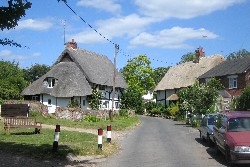 Brightwell-cum-Sotwell
lies just off the A4130 a couple of miles west of Wallingford
in the shadow of the Sinodun Hills. It is a village of
picture postcard prettiness and is fortunate to be completely
bypassed which means that the only traffic in the village
is village traffic. This means that Brightwell cum Sotwell seems a peaceful village to walk around. At the heart of the village is the
Red Lion pub which has been carefully restored after a
near-disastrous fire.
Brightwell-cum-Sotwell
lies just off the A4130 a couple of miles west of Wallingford
in the shadow of the Sinodun Hills. It is a village of
picture postcard prettiness and is fortunate to be completely
bypassed which means that the only traffic in the village
is village traffic. This means that Brightwell cum Sotwell seems a peaceful village to walk around. At the heart of the village is the
Red Lion pub which has been carefully restored after a
near-disastrous fire. 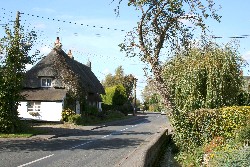 Chalgrove is approximately three
miles north-west of
Chalgrove is approximately three
miles north-west of 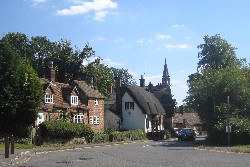 Clifton
Hampden is an attractive Thames-side village about four and a half
miles south west of Abingdon on the A415, and about one and a half
miles north of
Clifton
Hampden is an attractive Thames-side village about four and a half
miles south west of Abingdon on the A415, and about one and a half
miles north of 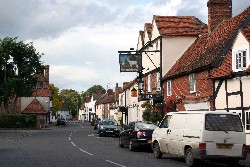 Dorchester is an attractive and prosperous Thames-side village about
5 miles north-west of Wallingford. On the edge of the village is the site of an Iron
Age settlement and also the site of the Roman town of Dorcic. Apart from those attractions there is also Dorchester Abbey, which was a former Augustinian abbey. The Abbey is now just the parish church but it does have a tea room and museum for the visitor to see. All in all, Dorchester is well worth a visit!
Dorchester is an attractive and prosperous Thames-side village about
5 miles north-west of Wallingford. On the edge of the village is the site of an Iron
Age settlement and also the site of the Roman town of Dorcic. Apart from those attractions there is also Dorchester Abbey, which was a former Augustinian abbey. The Abbey is now just the parish church but it does have a tea room and museum for the visitor to see. All in all, Dorchester is well worth a visit! 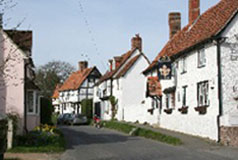 East Hagbourne lies
between Didcot and the Berkshire Downs, about a mile south
of Didcot on the B4016. It is medium sized and extremely attractive village with
many old houses with character. The most attractive part to visit is around Main Road, which is off the B4016. Leading from Main Road on both sides are footpaths that lead to attractive hidden parts of the village, including one path that runs between two streams, one on each side of the path!
East Hagbourne lies
between Didcot and the Berkshire Downs, about a mile south
of Didcot on the B4016. It is medium sized and extremely attractive village with
many old houses with character. The most attractive part to visit is around Main Road, which is off the B4016. Leading from Main Road on both sides are footpaths that lead to attractive hidden parts of the village, including one path that runs between two streams, one on each side of the path!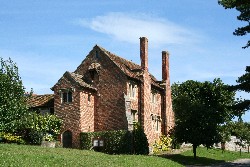 Ewelme is an attractive little village and a delight
to visit, with plenty to see. It lies in a small valley just south of the
B4009
Ewelme is an attractive little village and a delight
to visit, with plenty to see. It lies in a small valley just south of the
B4009 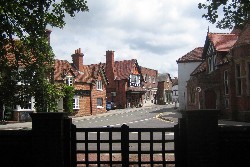 Everyone
who has heard of Goring associates it with the attractive
gap between the Berkshire Downs and the Chilterns known
as the Goring Gap. Here the villages of Goring and Streatley
stand on opposite sides of the River Thames, Oxfordshire
on one side and West Berkshire on the other, linked by
a fine bridge which was built in 1923. The beautiful riverside
setting and the attractive views of the hills on either
side make Goring an extremely attractive village.
Everyone
who has heard of Goring associates it with the attractive
gap between the Berkshire Downs and the Chilterns known
as the Goring Gap. Here the villages of Goring and Streatley
stand on opposite sides of the River Thames, Oxfordshire
on one side and West Berkshire on the other, linked by
a fine bridge which was built in 1923. The beautiful riverside
setting and the attractive views of the hills on either
side make Goring an extremely attractive village.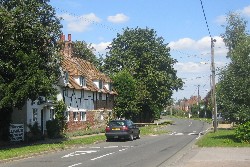 Long
Wittenham is an attractive Thames-side village about two
miles north of Didcot, but disappointingly the river is
not visible from the road unless you proceed towards
Long
Wittenham is an attractive Thames-side village about two
miles north of Didcot, but disappointingly the river is
not visible from the road unless you proceed towards 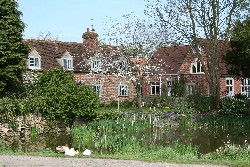 Approaching
Marsh Baldon from the direction of
Approaching
Marsh Baldon from the direction of 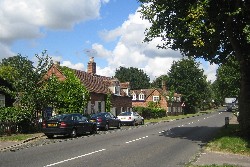 I've included Nuneham Courtenay here because it is an unusual village of small, mainly
semi-detached, single storey, and very uniform
cottages
which line each side of the main road, the
A4074, five
miles south east of Oxford. The
cottages are
brick built with tiled roofs and dormers in the attic
and shutters to the windows on the ground floor.
I've included Nuneham Courtenay here because it is an unusual village of small, mainly
semi-detached, single storey, and very uniform
cottages
which line each side of the main road, the
A4074, five
miles south east of Oxford. The
cottages are
brick built with tiled roofs and dormers in the attic
and shutters to the windows on the ground floor.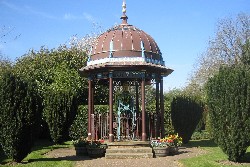 Visitors to Stoke Row usually go to see the attractive
Indian-style well, known as the Maharaja's Well, which was dug in the
19th century entirely by hand as a gift from the Maharajah of Benares
due to his friendship with a prominent local landowner,
Mr Edward Anderdon Reade.
Visitors to Stoke Row usually go to see the attractive
Indian-style well, known as the Maharaja's Well, which was dug in the
19th century entirely by hand as a gift from the Maharajah of Benares
due to his friendship with a prominent local landowner,
Mr Edward Anderdon Reade.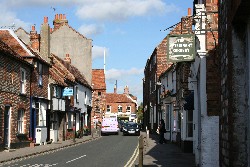 Town
or village? Technically Watlington is an ancient market
town and it claims to be reputedly the smallest town in
England. But
I feel justified in including Watlington here as one of Oxfordshire's
villages. Watlington has lots of character and it really would
have been a pity to exclude it for being a town.
Town
or village? Technically Watlington is an ancient market
town and it claims to be reputedly the smallest town in
England. But
I feel justified in including Watlington here as one of Oxfordshire's
villages. Watlington has lots of character and it really would
have been a pity to exclude it for being a town.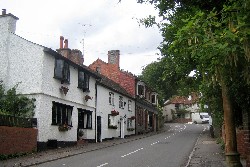 Whitchurch-on-Thames
is an attractive Thames-side village about half way between
Whitchurch-on-Thames
is an attractive Thames-side village about half way between